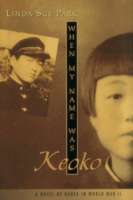
Sun-hee and her older brother Tae-yul are proud of their Korean heritage. Yet they live their lives under Japanese occupation. All students must read and write in Japanese and no one can fly the Korean flag. Hardest of all is when the Japanese Emperor forces all Koreans to take Japanese names. Sun-hee and Tae-yul become Keoko and Nobuo. Korea is torn apart by their Japanese invaders during World War II. Everyone must help with war preparations, but it doesn’t mean they are willing to defend Japan. Tae-yul is about to risk his life to help his family, while Sun-hee stays home guarding life-and-death secrets.
Jane Addams Honor Book
Featured in Volume I, Issue 1 of WOW Review.
This book has been included in WOW’s Language and Learning: Children’s and Young Adult Fiction Booklist. For our current list, visit our Booklist page under Resources in the green navigation bar.
Related: Historical Fiction, Intermediate (ages 9-14), Korea, Young Adult (ages 14-18)
- ISBN: 9780618133352
- Author: Park, Linda Sue
- Published: 2002, Clarion Books
- Themes: Family, Identity, Occupation, Tradition, World War II
- Descriptors: Historical Fiction, Intermediate (ages 9-14), Korea, Young Adult (ages 14-18)
- No. of pages: 208

I would be carefully recommending “So Far from the Bamboo Grove by Yoko Kawashima Watkins” before you actually use it in classroom because of the controversy around accuracy and authenticity in this story. The author’s genre claim as historical fiction later changed as memoire when her descriptions of historical events and ecological conditions in North Korea regions were in questions.. After her change of genre as memoire, arguments of a young child’s “correct” memory seemed to get defended as accuracy was critiqued. Not only accuracy,the father of Watkins’ and his occupational roles during WW II has stirred up more anger among Koreans as if Natzi kids’ memoire got attacted distorting WW II experiences.
Becca
This story was a particularly moving story of family struggling with the occupation of Japan in Korea during WWII. The story is told through the eyes of Sun-hee, a young Korean girl, and her brother, Tae-yul. Not only was their family displaced, but they was forced to “be” Japanese, so much so they were forced to change their name names to Japanese names, and to work for and fight for the Japanese. I thought Park did a phenomenal job of enabling the reader to feel and experience what Sun-hee and her family went through. What made the book particularly compelling was the author, Linda Sue Park, is an insider to this culture and it is apparent throughout the story. She described in detail the family structure, sleeping arrangements, the kimchee pot, how Korean’s count their age and so on. Although this book is fictional, many pieces come from family stories. The development of Sun-hee’s character to me was powerful. it was amazing to watch a young girl grow in courage and responsibility in a time of great challenge. Park definitely painted a clear picture of strong emotions like fear and love. Although this book was somewhat sad at time, Park found a way to celebrate Korean tradition in her writing and I think this grew out of her love for her own culture and heritage.
Holly
I agree, Becca. I really enjoyed reading this story, if you can think about the family’s displacement and enjoyment simultaneously. Another story that would go nicely with this one is So Far from the Bamboo Grove by Yoko Kawashima Watkins. Told from another perspective, of those who were Japanese living in Korea at the time of WWII and what they needed to do to get out of Korea when sentiment about the war and the Japanese (who were the conquering people in Korea prior to WWII) turned strongly against them. It is interesting to read these two books together. Both are displacement stories, as all of our stories this month have been, and I think the issue of displacement is of great importance to think about and understand, especially if we are outsiders to the struggle.
A very interesting twist on World War 2, “When My Name Was Keoko” immerses the reader in the perspective of Korean and Chinese cultures during this difficult time. It was very interesting to see how difficult life was during the war for both families and students. Because of the strict rules placed on the people of Korea, they were not allowed to keep their own names, tell folk tales that were created before the war, or even hang the Korean flag.
Having heard the perspective of American hisotry in school, and through discussions with Americans, I can honestly say I never really considered what life was like for other cultures that were involved. Having analyzed the perspective of other countries, it was eye opening to understand how dramatically the war effected others worldwide.